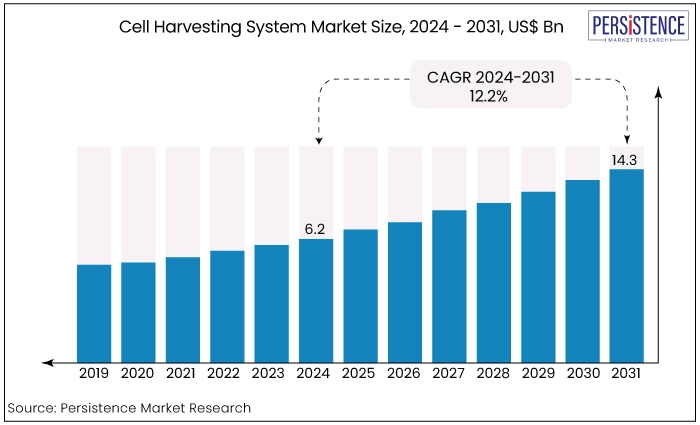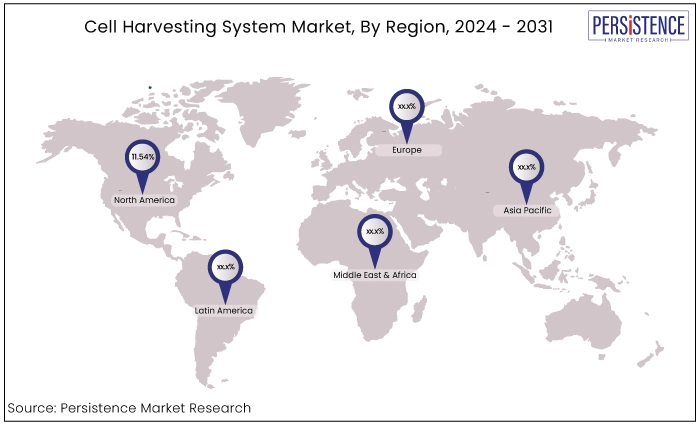Cell Harvesting System Market
Industry: Healthcare
Published Date: August-2024
Format: PPT*, PDF, EXCEL
Delivery Timelines: Contact Sales
Number of Pages: 195
Report ID: PMRREP34752
The global cell harvesting system market is estimated to value at US$14.3 Bn by the end of 2031 from US$6.2 Bn recorded in 2024. The market is projected to secure a CAGR of 12.2% in the forthcoming years from 2024 to 2031. North America currently dominates the market, followed by Europe and Asia-Pacific, owing to robust healthcare infrastructure and rising investments in biotechnology. The market is expected to expand as more healthcare providers adopt automated cell harvesting technologies to improve efficiency and precision.

Key Highlights of the Market
|
Market Attributes |
Key Insights |
|
Cell Harvesting System Market Size (2024E) |
US$6.2 Bn |
|
Projected Market Value (2031F) |
US$14.3 Bn |
|
Global Market Growth Rate (CAGR 2024 to 2031) |
12.2% |
|
Historical Market Growth Rate (CAGR 2019 to 2023) |
10.1% |
|
Region |
CAGR through 2031 |
|
North America |
11.54% |
North America is a significant shareholder in the global market and is expected to expand at a CAGR of 11.54% during the forecast period. This is due to the region’s advanced healthcare infrastructure, substantial investments in biotechnology, and robust research activities. The region's leading hospitals, biotech companies, and academic institutions drive high demand for cutting-edge cell harvesting technologies.
Strong support from government initiatives, favourable regulatory environments, and high adoption rates of automated systems further bolster market growth. Additionally, North America's emphasis on personalized medicine and regenerative therapies fuels the need for efficient, scalable cell harvesting solutions, positioning it as a dominant player in the global market.

|
Region |
CAGR through 2034 |
|
East Asia |
14.22% |
East Asia market is projected to secure a CAGR of 14.22% in the forecast period from 2024 to 2031 due to rapid advancements in biotechnology and significant investments in healthcare infrastructure. The region's expanding emphasis on advanced medical research and diagnostics increases the demand for sophisticated cell harvesting technologies.
The investment will support FUJIFILM Cellular Dynamics, Inc., specializing in iPSC and derived cells, and FUJIFILM Diosynth Biotechnologies in California, enhancing their capacity for various cell therapies, including iPSC-derived, CTL, CAR-T, TCR, NK, and tissue-based treatments.
Increasing research activities in academic and research institutions, coupled with supportive government policies and funding, further stimulate market growth. Additionally, the rising prevalence of chronic diseases and a growing patient population contribute to the expansion of cell-based treatments. East Asia's emerging market dynamics and technological advancements make it a key player with substantial growth potential.
|
Category |
Projected CAGR through 2031 |
|
Product- Automated Cell Harvesters |
13.41% |
The automated cell harvesters segment is set to dominate the global market in 2023 and is likely to maintain its dominance during in the forthcoming years recording a CAGR of 13.41%. This growth is driven by superior efficiency, precision, and scalability of automated systems compared to manual systems.
Automated systems reduce human error, enhance reproducibility, and allow for high-throughput processing, making them ideal for large-scale applications in research, biotech, and clinical settings. They streamline workflows, minimize labour costs, and accelerate production timelines, catering to the growing demand for advanced cell therapies and personalized medicine.
Additionally, technological advancements and increasing investments in automation further drive their adoption, positioning automated cell harvesters as a dominant segment in the market.
|
Category |
Projected CAGR through 2031 |
|
Application- Biopharmaceutical Applications |
12.54% |
Biopharmaceutical applications account for a considerable share of the global market due to their critical role in the development and production of advanced therapies including monoclonal antibodies, vaccines, and cell-based treatments.
The biopharmaceutical sector's rapid growth is driven by increasing investments in research and development, a rising demand for personalized medicine, and advancements in biotechnology.
Cell harvesting systems are essential for efficiently processing and purifying therapeutic cells, ensuring high-quality product yields. The expanding focus on innovative treatments for chronic and complex diseases further propels the demand for sophisticated cell harvesting technologies in this sector.
The cell harvesting system market encompasses technologies and equipment designed to collect and process cells from biological samples for use in research, diagnostics, and therapeutic applications. Cell harvesting is a critical step in the development of cell-based therapies, including regenerative medicine and immunotherapies, where precise and efficient cell collection is essential.
The market includes various systems such as manual and automated cell harvesters, cell culture systems, and processing equipment. With advancements in biotechnology and a growing demand for personalized medicine, the cell harvesting system sector is expanding rapidly. Innovations in automation, gene editing, and cell processing are driving growth, offering enhanced efficiency and precision in cell-based applications and contributing to the overall advancement of medical treatments and research.
The global market for cell harvesting systems has seen substantial growth over the past decade, driven by advancements in biotechnology, increased investment in cell-based therapies, and the rising prevalence of chronic diseases. Historically, the market has expanded due to innovations in cell processing technologies and the growing demand for personalized medicine.
Key developments include the introduction of automated systems that enhance efficiency and scalability, as well as the integration of advanced gene editing techniques like CRISPR. The market is expected to continue its upward trajectory as new therapies and technologies emerge. The increasing focus on regenerative medicine and personalized treatments will drive demand for advanced cell harvesting solutions.
Expanding healthcare infrastructure in emerging markets and supportive regulatory frameworks are anticipated to further fuel growth. As research and development in cell-based therapies advance, the market will likely to see continuous innovation and expansion, positioning itself as a pivotal component of modern medical and research practices.
Growing Investments in Research & Development
Increased funding and support for biopharmaceutical research and clinical trials fuel advancements in cell-based therapies and regenerative medicine. This influx of capital accelerates the development of innovative cell processing technologies, supports extensive clinical trials, enhances the quality of research, and supports the commercialization of new treatments.
As companies and governments invest more in research and development, they drive the creation of cutting-edge solutions that address complex medical challenges. Additionally, robust investment in clinical trials facilitates the validation and adoption of new therapies, expanding market opportunities and fostering growth in the cell harvesting sector. This trend underscores the importance of sustained financial commitment to advancing medical science.
Enhanced regulatory support drives market growth in the cell harvesting sector by accelerating the development and approval of new technologies. Favourable policies and streamlined approval processes reduce delays, enabling faster market entry for advanced cell therapies. This supportive regulatory environment lowers barriers to innovation by providing clear guidelines and expediting review times.
Regulatory incentives, such as expedited approval programs and research grants, encourage investment and development in cell harvesting technologies. As a result, companies introduce novel solutions to meet the increasing demand for advanced therapeutics, contributing significantly to market expansion. This efficient regulatory framework thus plays a crucial role in driving industry progress and growth.
High Costs of Advanced Technologies
High costs associated with advanced cell harvesting technologies pose a significant challenge for market growth. The price of sophisticated equipment and the operational expenses required for maintaining and running these systems can be prohibitively high, particularly for small players and emerging biotech firms. This financial barrier limits the ability of smaller or new market entrants to access cutting-edge technology and compete effectively.
High costs can restrict innovation and slow down the adoption of new technologies in various regions, particularly in developing markets. Addressing these financial constraints through cost-effective solutions and scalable technologies can help widen market participation and drive overall growth. Consequently, finding ways to reduce these costs represents a crucial opportunity for advancing market expansion and fostering a more inclusive industry.
Infrastructural Constraints in Emerging Markets
Infrastructure constraints in emerging markets significantly impact the adoption of advanced cell harvesting technologies. Inadequate facilities, such as outdated laboratories and insufficient storage conditions, can hinder the implementation of sophisticated cell processing systems. These limitations affect the reliability and efficiency of cell harvesting operations, making it challenging to maintain high-quality standards and comply with regulatory requirements.
The lack of robust infrastructure delays the development and commercialization of new therapies, limiting market growth. To overcome these barriers, investments in upgrading infrastructure and enhancing local healthcare facilities are essential.
Expansion into Emerging Markets
Expansion into emerging markets represents a significant opportunity for market players. Regions like East Asia, Latin America, and parts of Africa are experiencing rapid growth in healthcare infrastructure, increasing their demand for advanced cell processing technologies.
By entering these markets, companies capitalize on the rising need for sophisticated cell therapies and biopharmaceuticals driven by improving economic conditions and growing investments in healthcare.
This expansion offers players the chance to establish a strong market presence, diversify their revenue streams, and foster strategic partnerships with local institutions. Ultimately, tapping into emerging markets not only boosts growth potential but also strengthens competitive positioning on a global scale, ensuring long-term success in a dynamic industry.
Innovations in Cell Processing
Innovations in cell processing present significant opportunities for the manufacturers of cell harvesting systems. By developing advanced techniques that improve yield and quality, companies help meet the increasing demand for high-quality cell therapies and regenerative medicine.
Enhanced processing methods such as optimized cell separation and purification enable more efficient production, reduce costs, and support complex therapeutic applications. These innovations also align with the push for personalized medicine, where precise and reliable cell processing is crucial. For market players, investing in cutting-edge technologies not only drives competitive advantage but also positions them to lead in a rapidly evolving industry.
The competitive landscape for the cell harvesting system market features a diverse range of players, from established industry leaders to innovative startups. Key competitors include major biotechnology and medical technology companies, which offer advanced automated systems enhancing efficiency and scalability.
Companies focus on technological innovations, such as improved automation, integration with other laboratory systems, and enhanced user interfaces. Market dynamics are influenced by strategic partnerships, mergers, and acquisitions aimed at expanding capabilities and market reach.
Recent Developments in the Cell Harvesting System Market
|
Attributes |
Details |
|
Forecast Period |
2024 to 2031 |
|
Historical Data Available for |
2019 to 2023 |
|
Market Analysis |
US$ Billion for Value |
|
Key Regions Covered |
|
|
Key Market Segments Covered |
|
|
Key Companies Profiled in the Report |
|
|
Report Coverage |
|
|
Customization & Pricing |
Available upon request |
By Product
By Application
By End User
By Region
To know more about delivery timeline for this report Contact Sales

Advancements in regenerative medicine and increasing applications in personalized therapies are the key factors surging demand for cell harvesting system.
Some of the key players operating in the market are Cytiva (Danaher), Esco VacciXcell, and Colder Products Company (Dover).
The automated cell harvesters product type recorded the significant market share in 2023.
A compelling opportunity lies in developing automated, scalable solutions that enhance efficiency and precision.
North America is set to account for the significant share in the market.